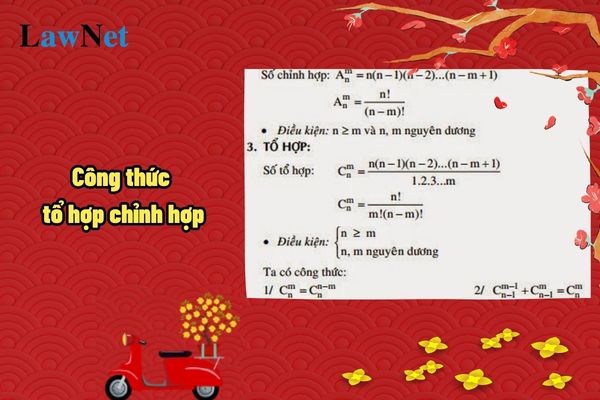What are the partial permutation and combination formulas? In Vietnam, what is the grade at which the Mathematics curriculum includes partial permutation and combination formulas?
What are the partial permutation and combination formulas in Vietnam?
10th-grade students can explore the partial permutation and combination formulas below:
|
What are the partial permutation and combination formulas in Vietnam? Partial permutation and combination are two important concepts in mathematics, particularly in probability and statistics theory. They are used to calculate the number of ways to select elements from a set, each with different order conditions. |
*Note: Information is for reference only./.

What are the partial permutation and combination formulas? In Vietnam, what is the grade at which the Mathematics curriculum includes partial permutation and combination formulas? (Image from Internet)
In Vietnam, what is the grade at which the Mathematics curriculum includes partial permutation and combination formulas?
According to Section 5 of the Appendix of the General Education Program for Mathematics issued with Circular 32/2018/TT-BGDDT, the requirements for 10th-grade Mathematics are as follows:
Combinatorial Algebra
Counting rules (addition rule, multiplication rule, partial permutations, arrangements, combinations) and applications in practice
- Apply addition and multiplication rules in some simple situations (e.g., counting the number of heads/tails outcomes when flipping several coins,...).
- Apply tree diagrams in simple counting problems in mathematics, other subjects, and in practice (e.g., counting the number of formed zygotes in Biology, or counting the number of matches in a sports tournament,...).
- Calculate the number of partial permutations, arrangements, combinations.
- Calculate the number of partial permutations, arrangements, combinations using a calculator.
Newton's binomial with exponents not exceeding 5
Expand the Newton's binomial (a + b)^n with a low exponent (n = 4 or n = 5) by applying combinations.
Thus, according to the regulations, the 10th-grade Mathematics curriculum includes partial permutation and combination formulas.
What are the regulations on assessing learning results for 10th-grade Mathematics in Vietnam?
According to Section 7 of the General education program in Mathematics issued with Circular 32/2018/TT-BGDDT:
- The assessment of learning results for Mathematics aims to provide accurate, prompt, and valuable information about students' competency development and progress based on the requirements achieved in each grade and education level;
Adjust teaching activities to ensure the progress of each student and improve the quality of mathematics education specifically and education in general.
- Apply a combination of multiple assessment forms (process assessment, periodic assessment), many assessment methods (observation, process recording, oral response, objective tests, essays, written tests, practice exercises, learning projects/products, praktyczne zadania,...) and at appropriate times.
- Process assessment (or continuous assessment) is organized by the teacher in charge of the subject, combined with the assessment of teachers of other subjects, the assessed student, and other students in the group, in the grade, or parents.
Process assessment goes hand in hand with the student's learning activities, avoiding separation between the teaching and assessment processes, ensuring the goal of assessment for progress in students' learning.
- Periodic assessment (or summary assessment) is mainly to evaluate the achievement of learning objectives.
Periodic assessment and summary assessment results are used to certify learning levels, recognize students' achievements.
Periodic assessment is organized by the educational institution or through national tests and assessments.
- Periodic assessment is also used to manage teaching activities, ensure quality in the educational institution, and serve the development of the mathematics curriculum.
- Evaluate students' capabilities through evidence showing the results achieved in students' actions.
The assessment process includes basic steps such as: identifying assessment purposes; determining necessary evidence; selecting appropriate methods and tools for assessment; collecting evidence; interpreting evidence, and making comments.
- Pay attention to selecting methods and tools for evaluating components of mathematical competence. Specifically:
+ Assess mathematical reasoning and reasoning ability: some methods and tools can be used, such as questions (oral, written), and exercises,... that require students to present, compare, analyze, aggregate, and systematize knowledge;
Use mathematical knowledge to explain and reason.
+ Assess mathematical modeling ability: select situations in practice that give rise to mathematical problems.
From there, require students to identify a mathematical model (consisting of formulas, equations, tables, graphs,...) for the situation in the practical problem;
Solve the mathematical problems in the established model; express and evaluate solutions in a practical context, and improve the model if the solution does not fit.
+ Assess mathematical problem-solving ability: methods such as asking learners to identify situations, detect, and present the problem that needs solving can be used;
Describe and explain initial information, goals, and desires of the situation being considered; collect, select, arrange information, and connect with existing knowledge;
Use questions (which may require oral or written responses) that require learners to use knowledge to solve problems, especially practical problems; use observation methods (such as checklists according to predetermined criteria), observe learners during problem-solving;
Evaluate through learners' practical products (such as products from learning projects); reasonably consider integrative assessment tasks.
+ Assess mathematical communication ability: methods such as asking learners to understand listening, reading understanding, taking notes (summarizing), analyzing, selecting, and extracting key mathematical information, and focusing on spoken or written texts;
Use mathematical language combined with common language to present, express, ask questions, discuss, and argue mathematical content, ideas, and solutions in interaction with others.
+ Assess the ability to use mathematical tools and means: methods such as asking learners to recognize names, functions, usage specifications, maintenance methods, advantages, and limitations of mathematical tools, and means can be used;
Present the (reasonable) use of mathematical tools and means to perform learning tasks or to describe mathematical arguments and proofs.
When teachers plan lessons, it is necessary to establish criteria and assessment methods to ensure that by the end of each lesson, students meet basic requirements based on the stated criteria before proceeding with subsequent learning activities.

